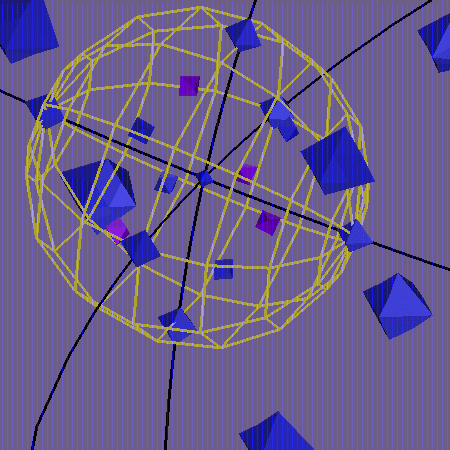What is the Binary Tetrahedral Group?
 |
This picture shows the Binary Tetrahedral Group
embedded as a subgroup of the matrix group SU(2).
SU(2) is geometrically a 3-dimensional sphere of
radius one; here we see a conformal projection of that
sphere into 3-space.
The point 1 is at the intersection of the three black
circles of longitude. The six points $\pm {\bf i}, {\bf j}, {\bf k}$
at the intersections of these circles with the yellow
equatorial sphere. Eight other group points lie
inside the sphere, at a distance $\frac{\pi}{3}$ from 1. They
are $a,b,c,d$ (colored violet) and $-a^2,-b^2,-c^2,-d^2$.
Six of the nine points outside the equatorial sphere
are visible here. They appear larger because they are
closer to the projection point (near $-1$). The image
of the point $-1$ itself has been suppressed. It would
occupy the whole background. This image was produced,
using GeomView modules developed at the Geometry Center,
by Summer Institute student Rebecca Frankel.
|
The Tetrahedral Group is the group of orientation-
preserving symmetries
of an equilateral tetrahedron.
If the vertices of the tetrahedron are labeled A,B,C,D, each
of the symmetries may be represented as a permutation of
these four symbols. Each even permutation corresponds to
an orientation-preserving symmetry. The twelve are
- the identity
- eight rotations about axes going through a vertex and
the opposite face. There are four vertices; each rotation can be
by 120$^{\circ}$ or 240$^{\circ}$
(ABC), (ACB), (ABD), (ADB), (ACD), (ADC), (BCD), (BDC),
- three 180$^{\circ}$ rotations about axes joining
the midpoints of two opposite edges:
(AB)(CD), (AC)(BD), (AD)(BC).
If the tetrahedron is centered
at the origin in 3-space, these symmetries correspond to
as rigid rotations of 3-space, and can be represented
by orthogonal 3 by 3 matrices, elements of the Special
Orthogonal matrix
group SO(3). This exhibits the Tetrahedral
Group as a subgroup of SO(3).
The Special Unitary group SU(2) consists of
2 by 2 complex matrices of the form
$$
\left ( \begin{array}{cc} (x+iy) & (z+iw)\\(-z+iw)&(x-iy)\end{array}\right )
$$
with determinant $x^2 + y^2 + z^2 + w^2 = 1$.
There is a group homomorphism SU(2) $\rightarrow$ SO(3)
which can be described in terms of $x,y,z,w$ but which
can be more geometrically defined using quaternions.
A quaternion can be identified with a matrix like the
one above, but without the determinant condition
in general. The quaternionic notation for that matrix
is ${\bf 1}x + {\bf i}y + {\bf j}z + {\bf k}w$,
where ${\bf 1},{\bf i}, {\bf j}, {\bf k}$ correspond to the matrices
$$\left ( \begin{array}{cc}1&0\\0&1\end{array}\right ),
\left ( \begin{array}{cc}i&0\\0&-i\end{array}\right ),
\left ( \begin{array}{cc}0&1\\-1&0\end{array}\right ),
\left ( \begin{array}{cc}0&i\\i&0\end{array}\right )$$
respectively. The rules for multiplying quaternions
follow from the rules for matrix multiplication;
equivalently: ${\bf i}^2 = {\bf j}^2 = {\bf k}^2 = -{\bf 1}$, ${\bf i}{\bf j} = -{\bf j}{\bf i} = {\bf k},$
${\bf j}{\bf k} = -{\bf k}{\bf j} = {\bf i}$, ${\bf k}{\bf i} = -{\bf i}{\bf k} = {\bf j}$, extended linearly.
The condition $x^2 + y^2 + z^2 + w^2 = 1$ defines
a unit quaternion. Since the matrix corresponding
to the unit quaternion
${\bf 1}x + {\bf i}y + {\bf j}z + {\bf k}w$
has unit determinant, its inverse
is exactly
$$
\left ( \begin{array}{cc} (x-iy) & (-z-iw)\\(z-iw)&(x+iy)\end{array}\right )
$$
so the multiplicative
inverse of the unit quaternion ${\bf 1}x + {\bf i}y + {\bf j}z + {\bf k}w$
is ${\bf 1}x - {\bf i}y - {\bf j}z - {\bf k}w$.
The vector $(a,b,c)$ in ${\bf R}^3$ can be identified with
the pure imaginary quaternion $a{\bf i} + b{\bf j} + c{\bf k}$;
then each quaternion ${\bf q}$ defines a linear map
$L({\bf q}): {\bf R}^3 \rightarrow {\bf R}^3$ by $L({\bf q})(a{\bf i} + b{\bf j} + c{\bf k}) =
{\bf q} \times (a{\bf i} + b{\bf j} + c{\bf k}) \times {\bf q}^{-1}$, using quaternionic
multiplication. It is straightforward to check
that $L({\bf q})$ is also pure imaginary; the fact that
the determinant of a product is the product of the
determinants then guarantees that $L({\bf q})$ is a
length-preserving, and therefore orthogonal,
transformation; the question of orientation
can be answered by noting that $L(1)$ is the
identity and that SU(2) is connected. Also,
the definition yields immediately that $L$ is
a homomorphism from SU(2) to SO(3):
$L({\bf pq}) = L({\bf p})L({\bf q})$ for any
two unit quaternions ${\bf p}$ and ${\bf q}$. Finally,
two unit quaternions ${\bf p}$ and ${\bf q}$ give the same SO(3)
element if and only if ${\bf p} = \pm {\bf q}$; the condition
is equivalent to the three equations $L({\bf q}^{-1}{\bf p}){\bf i} = {\bf i}$,
$L({\bf q}^{-1}{\bf p}){\bf j} = {\bf j}$, $L({\bf q}^{-1}{\bf p}){\bf k} = {\bf k}$;
writing ${\bf q}^{-1}{\bf p} = {\bf 1}x + {\bf i}y + {\bf j}z + {\bf k}w$
in these three equations
yields $x^2 = 1$, $y = z = w = 0$, so ${\bf q}^{-1}{\bf p} = \pm 1$,
i.e. ${\bf p} = \pm {\bf q}$.
For obvious reasons, then, the map $L$ is called the
double-covering homomorphism from SU(2) to SO(3).
Since the tetrahedral group is a 12-element
subgroup of SO(3), the SU(2) matrices which map
to elements of the tetrahedral group will form a
24-element subgroup of SU(2). This is the
Binary Tetrahedral Group.
Click here for an explicit
description of the elements of the Binary Tetrahedral
Group in terms of quaternions.
Reset using LaTeX, 3/6/23.
Back to Bimary Tetrahedral Main Page
Back to Tony's Home Page
